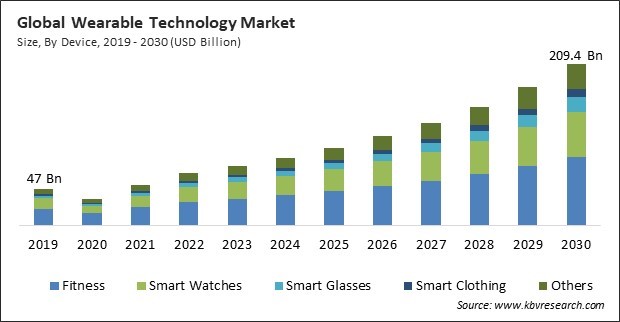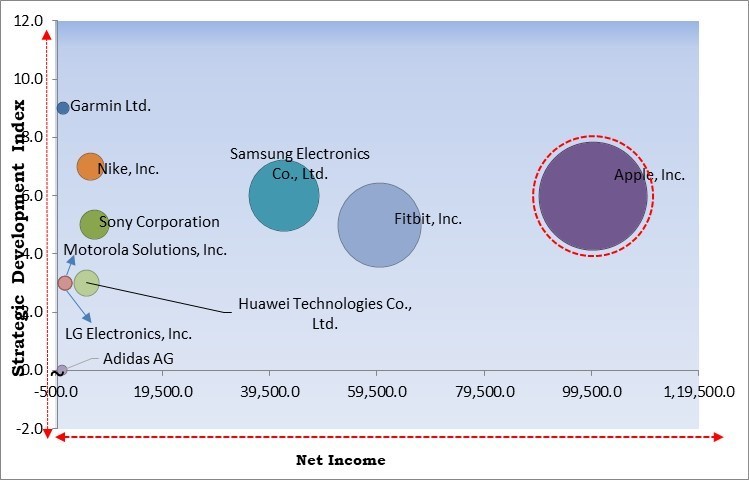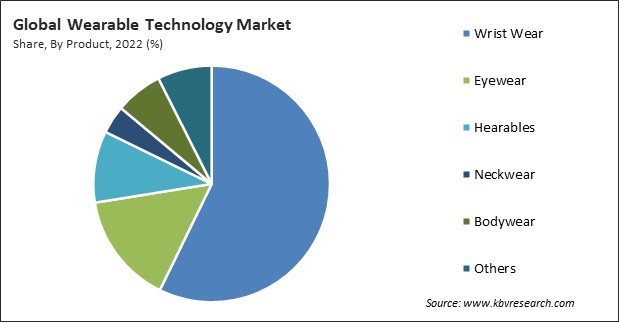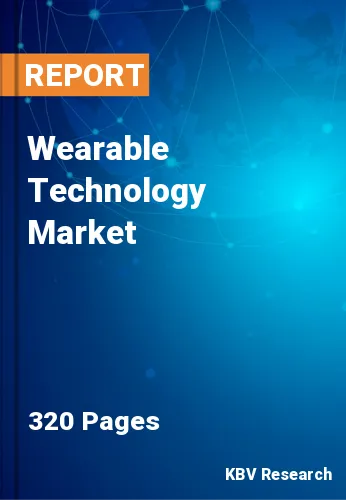The Global Wearable Technology Market size is expected to reach $209.4 billion by 2030, rising at a market growth of 15.3% CAGR during the forecast period.
Wearable devices are gaining popularity in the healthcare industry as they enable continuous monitoring of patient's health metrics, facilitating remote patient care and reducing the need for frequent hospital visits. Consequently, with this increasing adoption of Wearable technology, the Healthcare segment would account for nearly 18% of the total market share by 2030. Some wearables offer medication reminders and adherence tracking, supporting patients in managing their medication routines. Wearable fitness trackers and smartwatches monitor physical activity, giving users insights into their daily steps, distance traveled, and burned calories.

The major strategies followed by the market participants are Product Launches as the key developmental strategy to keep pace with the changing demands of end users. For instance, In June, 2023, Nike, Inc. announced the launch of Aerogami, an apparel technology that is meant to be used by runners. The product features autonomous vents to deliver on-demand air intake during exercise. Additionally, In May, 2023, Garmin Ltd. released Edge 840, a series of cycling computers used for providing performance-based training metrics. The computer features a 60-hour battery life and compatibility with Varia cycling radars. Furthermore, the computers are pairable with Tacx indoor smart trainers.
Based on the Analysis presented in the KBV Cardinal matrix; Based on the Analysis presented in the KBV Cardinal matrix; Apple, Inc. is the forerunner in the Market. In June, 2023, Apple, Inc. announced the launch of Apple Vision Pro, a computer used for blending the physical world with digital content. The product features a visionOS spatial operating system and HD display with 23 million pixels. Companies such as Fitbit, Inc., Samsung Electronics Co., Ltd. and Sony Corporation are some of the key innovators in the Market.

Continuous advancements in miniaturization technologies have led to the creation of smaller and lighter components, enabling the development of sleek and unobtrusive wearable devices. Wearable devices are equipped with advanced sensors, including accelerometers, gyroscopes, heart rate monitors, and environmental sensors, providing accurate and real-time data. Integrating sensors and electronic components into fabrics enables the development of smart clothing, providing functionalities like health monitoring and activity tracking. Energy-efficient processors contribute to extended battery life, addressing one of the significant challenges in wearable technology. These technological advancements collectively contribute to the expansion of the market.
Wearable fitness trackers, such as smartwatches and fitness bands, offer users real-time data on their physical activity, including step count, distance traveled, and calories burned. Some wearables provide early warning systems by detecting irregularities in biometric data, facilitating early intervention and preventive healthcare. Additionally, Wearable devices play a role in chronic disease management by continuously monitoring conditions such as diabetes, hypertension, and cardiovascular diseases. Wearable devices integrate with telehealth platforms, allowing healthcare providers to remotely monitor patients' health data and adjust treatment plans as needed. The above factors will drive the market growth in the coming years.
Wearable devices with high upfront costs may be out of reach for a significant portion of the consumer market, limiting adoption, especially among price-sensitive consumers. High initial costs can result in a slower mass adoption rate, as consumers may hesitate to invest in wearable technology, mainly when alternatives are available at lower price points. High-priced wearables may lead to consumer skepticism, with users questioning whether the devices provide sufficient value or if the technology is mature enough to justify the investment. These factors will hamper the market growth.
On the basis of device, the market is segmented into fitness, smart watches, smart glasses, smart clothing, and others. The smartwatch segment acquired a substantial revenue share in the market in 2022. Smartwatches retain essential watch functions, displaying the time and date and often offering customizable watch faces to suit individual preferences. Smartwatches connect to smartphones, allowing users to receive notifications for calls, messages, emails, and app alerts directly on their wrists. Many smartwatches support NFC technology, enabling users to make contactless payments using services like Apple Pay, Google Pay, or Samsung Pay.
By product type, the market is fragmented into wrist wear, eyewear, hearables, neckwear, bodywear, and others. The hearables segment recorded a remarkable revenue share in the market in 2022. The expanding use of smart headwear and the increasing adoption of Virtual Reality (VR) and Augmented Reality (AR) headsets in the healthcare and multimedia sectors will contribute to the expansion of this segment. Moreover, the growing prevalence of smart caps is anticipated to stimulate segment growth due to their monitoring technology and data-driven insights. Globally, several businesses, including Spree Wearables and Life BEAM, are introducing smart headwear.

On the basis of application, the wearable technology market is classified into lifestyle, consumer appliances, entertainment, healthcare, fitness & sports, defense, and enterprise. The healthcare segment garnered a significant revenue share in the market in 2022. Increasing wearable device application diversity in the pharmaceutical industry will sustain segment expansion throughout the forecast period. Digital health enables healthcare practitioners to observe patients virtually. VR and AR innovations are attracting considerable interest in the health sector. Virtual reality (VR) technology is utilized in medical practice to aid in surgical training and procedures.
| Report Attribute | Details |
|---|---|
| Market size value in 2022 | USD 67.8 Billion |
| Market size forecast in 2030 | USD 209.4 Billion |
| Base Year | 2022 |
| Historical Period | 2019 to 2021 |
| Forecast Period | 2023 to 2030 |
| Revenue Growth Rate | CAGR of 15.3% from 2023 to 2030 |
| Number of Pages | 320 |
| Number of Table | 443 |
| Report coverage | Market Trends, Revenue Estimation and Forecast, Segmentation Analysis, Regional and Country Breakdown, Competitive Landscape, Porter’s 5 Forces Analysis, Company Profiling, Companies Strategic Developments, SWOT Analysis, Winning Imperatives |
| Segments covered | Device, Product Type, Application, Region |
| Country scope |
|
| Companies Included | Apple, Inc., Samsung Electronics Co., Ltd. (Samsung Group), Garmin Ltd., Motorola Solutions, Inc., Fitbit, Inc. (Google LLC), Nike, Inc., Adidas AG, LG Electronics, Inc. (LG Corporation), Sony Corporation and Huawei Technologies Co., Ltd. (Huawei investment & Holding Co., Ltd.) |
| Growth Drivers |
|
| Restraints |
|
Region-wise, the market is analysed across North America, Europe, Asia Pacific, and LAMEA. In 2022, the North America region witnessed the largest revenue share in the market. North America is renowned worldwide as the epicenter of all substantial technological advancements. In this geographic region, the expansion of disposable income and the swift assimilation and widespread use of advanced devices are significant catalysts. In addition, the region is home to numerous wearable technology companies, including Apple, Fitbit, and Garmin, contributing to the market's expansion.
Free Valuable Insights: Global Wearable Technology Market size to reach USD 209.4 Billion by 2030
The market research report covers the analysis of key stake holders of the market. Key companies profiled in the report include Apple, Inc., Samsung Electronics Co., Ltd. (Samsung Group), Garmin Ltd., Motorola Solutions, Inc., Fitbit, Inc. (Google LLC), Nike, Inc., Adidas AG, LG Electronics, Inc. (LG Corporation), Sony Corporation and Huawei Technologies Co., Ltd. (Huawei investment & Holding Co., Ltd.)
By Device
By Product Type
By Application
By Geography
This Market size is expected to reach $209.4 billion by 2030.
Advancements in wearable technology are driving the Market in coming years, however, High initial costs of wearable devices restraints the growth of the Market.
Apple, Inc., Samsung Electronics Co., Ltd. (Samsung Group), Garmin Ltd., Motorola Solutions, Inc., Fitbit, Inc. (Google LLC), Nike, Inc., Adidas AG, LG Electronics, Inc. (LG Corporation), Sony Corporation and Huawei Technologies Co., Ltd. (Huawei investment & Holding Co., Ltd.)
The expected CAGR of this Market is 15.3% from 2023 to 2030.
The Wrist Wear segment is leading the the Market by Product Type in 2022;there by, achieving a market value of $112.7 billion by 2030.
The North America region dominated the Market by Region in 2022 and would continue to be a dominant market till 2030;there by, achieving a market value of $69.2 billion by 2030.
Our team of dedicated experts can provide you with attractive expansion opportunities for your business.

